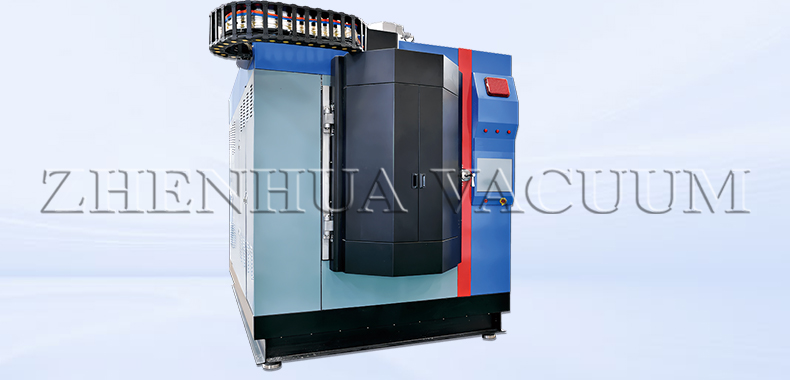Guangdong Zhenhua Technology Co., Ltd میں خوش آمدید۔
انڈسٹری نیوز
-

ڈائمنڈ پتلی فلموں کی ٹیکنالوجی - باب 1
گرم فلیمینٹ CVD کم دباؤ پر ہیرے اگانے کا سب سے قدیم اور مقبول طریقہ ہے۔ 1982 Matsumoto et al. ایک ریفریکٹری میٹل فلیمینٹ کو 2000 ° C سے زیادہ گرم کرتا ہے، جس درجہ حرارت پر فلیمینٹ سے گزرنے والی H2 گیس آسانی سے ہائیڈروجن ایٹم بناتی ہے۔ ایٹم ہائیڈروجن دور کی پیداوار...مزید پڑھیں -
ویکیوم کوٹنگ کے سامان کی درجہ بندی کیا ہیں؟
ویکیوم کوٹنگ ٹیکنالوجی ایک ایسی ٹیکنالوجی ہے جو ویکیوم ماحول کے تحت پتلی فلمی مواد کو سبسٹریٹ مواد کی سطح پر جمع کرتی ہے، جو الیکٹرانکس، آپٹکس، پیکیجنگ، سجاوٹ اور دیگر شعبوں میں بڑے پیمانے پر استعمال ہوتی ہے۔ ویکیوم کوٹنگ کا سامان بنیادی طور پر درج ذیل قسم میں تقسیم کیا جا سکتا ہے...مزید پڑھیں -
ویکیوم کوٹنگ کے سامان کے اچھے برانڈ کا انتخاب کیسے کریں؟
ویکیوم کوٹنگ کا سامان ویکیوم ٹیکنالوجی کا استعمال کرتے ہوئے سطح میں ترمیم کے لیے ایک قسم کا سامان ہے، جس میں بنیادی طور پر ویکیوم چیمبر، ویکیوم سسٹم، ہیٹ سورس سسٹم، کوٹنگ میٹریل وغیرہ شامل ہیں۔ اس وقت، ویکیوم کوٹنگ کا سامان بڑے پیمانے پر آٹوموٹو، موبائل فونز، آپٹکس، سی...مزید پڑھیں -
ویکیوم آئن کوٹنگ ٹیکنالوجی کا تعارف
1. ویکیوم آئن کوٹنگ ٹیکنالوجی کا اصول ویکیوم چیمبر میں ویکیوم آرک ڈسچارج ٹیکنالوجی کا استعمال کرتے ہوئے، کیتھوڈ مواد کی سطح پر آرک لائٹ پیدا ہوتی ہے، جس سے کیتھوڈ مواد پر ایٹم اور آئن بنتے ہیں۔ برقی میدان کے عمل کے تحت، ایٹم اور آئن بیم بمباری کرتے ہیں...مزید پڑھیں -
سپٹرنگ کوٹنگ مشین کی تکنیکی خصوصیات
ویکیوم میگنیٹران سپٹرنگ خاص طور پر ری ایکٹیو ڈیپوزیشن کوٹنگز کے لیے موزوں ہے۔ درحقیقت، یہ عمل کسی بھی آکسائیڈ، کاربائیڈ اور نائٹرائیڈ مواد کی پتلی فلمیں جمع کر سکتا ہے۔ اس کے علاوہ، یہ عمل خاص طور پر ملٹی لیئر فلمی ڈھانچے کو جمع کرنے کے لیے بھی موزوں ہے، بشمول آپٹی...مزید پڑھیں -
DLC ٹیکنالوجی کا تعارف
"DLC لفظ "DIAMOND-LIKE CARBON" کا مخفف ہے، کاربن عناصر پر مشتمل ایک مادہ ہے، جو فطرت میں ہیرے سے ملتا جلتا ہے، اور گریفائٹ ایٹموں کی ساخت رکھتا ہے۔ ڈائمنڈ لائک کاربن (DLC) ایک بے ساختہ فلم ہے جس نے قبائلی کمیونٹی کی توجہ مبذول کرائی ہے...مزید پڑھیں -

ڈائمنڈ فلموں کی خصوصیات اور اطلاق باب 2
ڈائمنڈ فلموں کی برقی خصوصیات اور ایپلی کیشنز ڈائمنڈ میں ممنوعہ بینڈوڈتھ، ہائی کیریئر موبلٹی، اچھی تھرمل چالکتا، ہائی سیچوریشن الیکٹران ڈرفٹ ریٹ، چھوٹا ڈائی الیکٹرک کنسٹنٹ، ہائی بریک ڈاؤن وولٹیج اور الیکٹران ہول موبلٹی وغیرہ بھی ہے۔ اس کا بریک ڈاؤن وولٹیج دو یا...مزید پڑھیں -

ڈائمنڈ فلموں کی خصوصیات اور اطلاقات باب 1
مضبوط کیمیائی بندھن کے ساتھ تشکیل پانے والے ہیرے میں خاص مکینیکل اور لچکدار خصوصیات ہیں۔ ہیرے کی سختی، کثافت اور تھرمل چالکتا معلوم مواد میں سب سے زیادہ ہے۔ ہیرے میں کسی بھی مواد کی لچک کا سب سے زیادہ ماڈیولس بھی ہوتا ہے۔ ہیرے کی رگڑ کا گتانک...مزید پڑھیں -

شمسی خلیوں کی قسم باب 2
Gallium arsenide (GaAs) Ⅲ ~ V کمپاؤنڈ بیٹری کی تبدیلی کی کارکردگی 28% تک، GaAs کمپاؤنڈ میٹریل میں ایک بہت ہی مثالی آپٹیکل بینڈ گیپ ہے، ساتھ ہی اعلی جذب کی کارکردگی، شعاع ریزی کے خلاف مضبوط مزاحمت، حرارت سے حساسیت، اعلی-جون فیکیشن کی تیاری کے لیے موزوں...مزید پڑھیں -

شمسی خلیوں کی قسم باب 1
شمسی خلیات کو تیسری نسل میں تیار کیا گیا ہے، جس کی پہلی نسل مونوکریسٹل لائن سلکان سولر سیلز ہے، دوسری جنریشن بیمار سلکان اور پولی کرسٹل لائن سلکان سولر سیلز ہیں، اور تیسری جنریشن کاپر-اسٹیل-گیلیم-سیلینائیڈ (CIGS) ہے جس کے نمائندے کے طور پر...مزید پڑھیں -

فلم پرت کی مکینیکل طاقت کو بہتر بنانے کے طریقے
جھلی کی تہہ کی مکینیکل خصوصیات چپکنے، تناؤ، جمع کثافت وغیرہ سے متاثر ہوتی ہیں۔ جھلی کی تہہ کے مواد اور عمل کے عوامل کے درمیان تعلق سے، یہ دیکھا جا سکتا ہے کہ اگر ہم جھلی کی تہہ کی مکینیکل طاقت کو بہتر بنانا چاہتے ہیں، تو ہمیں توجہ مرکوز کرنی چاہیے...مزید پڑھیں -

کیمیائی بخارات کا ذخیرہ
ایپیٹیکسیل گروتھ، جسے اکثر ایپیٹیکسی بھی کہا جاتا ہے، سیمی کنڈکٹر مواد اور آلات کی تعمیر میں سب سے اہم عمل ہے۔ نام نہاد epitaxial ترقی سنگل کرسٹل سبسٹریٹ میں سنگل پروڈکٹ فلم کے عمل کی ایک پرت کی ترقی پر مخصوص حالات میں ہوتی ہے، t...مزید پڑھیں -

سی وی ڈی ٹیکنالوجی کی اقسام
موٹے طور پر، CVD کو تقریباً دو قسموں میں تقسیم کیا جا سکتا ہے: ایک سنگل کرسٹل ایپیٹیکسیل پرت کے سبسٹریٹ بخارات کے جمع ہونے پر واحد پروڈکٹ میں ہے، جو کہ مختصر طور پر CVD ہے۔ دوسرا سبسٹریٹ پر پتلی فلموں کا جمع ہونا ہے، جس میں ملٹی پروڈکٹ اور بے ساختہ فلمیں شامل ہیں۔ ٹی کے مطابق...مزید پڑھیں -
ٹرانسمیشن اور ریفلیکٹنس سپیکٹرا اور آپٹیکل پتلی فلموں کا رنگ باب 2
اس سے ہم واضح کرنے والے ہیں: (1) پتلی فلم کے آلات، ترسیل، عکاسی سپیکٹرا اور اس کے درمیان متعلقہ تعلق کا رنگ، یعنی ایک رنگ کا سپیکٹرم؛ اس کے برعکس، یہ رشتہ "منفرد نہیں" ہے، جو رنگین ملٹی سپیکٹرم کے طور پر ظاہر ہوتا ہے۔ اس لیے فلم...مزید پڑھیں -
ٹرانسمیشن اور ریفلیکٹنس سپیکٹرا اور آپٹیکل پتلی فلموں کا رنگ باب 1
ٹرانسمیشن اور ریفلیکشن سپیکٹرا اور آپٹیکل پتلی فلموں کے رنگ پتلی فلمی آلات کی دو خصوصیات ہیں جو ایک ہی وقت میں موجود ہیں۔ 1. ٹرانسمیشن اور ریفلیکشن سپیکٹرم طول موج کے ساتھ آپٹیکل پتلی فلم کے آلات کی عکاسی اور ترسیل کے درمیان تعلق ہے۔ یہ ج...مزید پڑھیں









